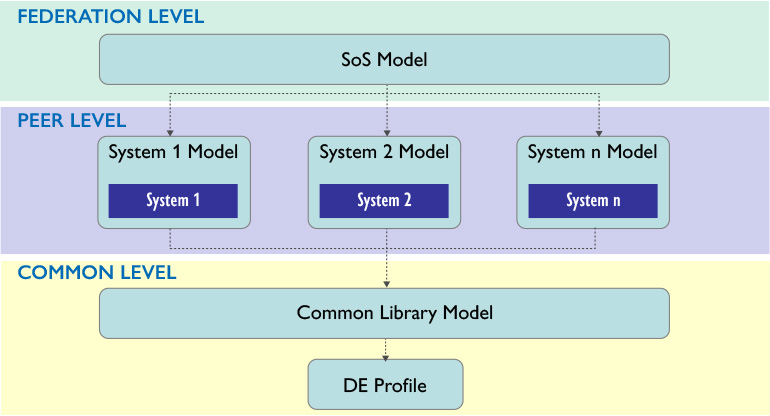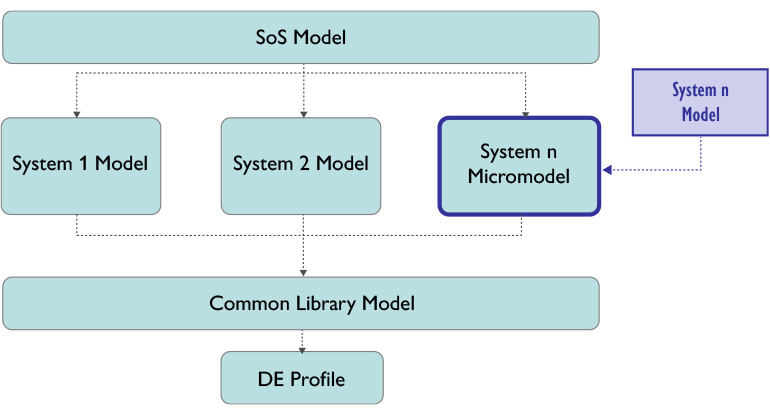Key Takeaways:
- Department of Defense services and agencies have many developers working on different systems and need a way to connect, or federate, those distinct systems into systems-of-systems.
- A federation systems modeling method using high-level, predefined, common elements supports data privacy among developers and makes development efforts more streamlined and accurate.
- Effectiveness of systems integrators in federating together models is critical to the success of system-of-systems development projects.
LISTEN TO THIS BLOG:
Systems engineering has evolved dramatically. Where it once involved a system in isolation, many systems now must be developed to work with other systems as a larger system-of-systems. Think of a smart home, where the thermostat might be connected to automated window blinds in multiple rooms as well as the central HVAC unit. All of these separate systems must work together to control the house’s temperature.
The need to connect many distinct systems is especially important for our Department of Defense (DOD) customers. A development program for a combat system, for example, has separate systems for sensing, command-and-control and weapons from their own developers and a systems integrator responsible for connecting them together. The complexity of each of these alone requires systems modeling — the creation of flow diagrams to map out the system’s architecture and structural elements and to describe characteristics, behaviors, functional capabilities and intended performance — to guide engineering and development.
In model-based systems engineering (MBSE), an organization uses sets of descriptive models that inform and document a system's attributes and guide multidisciplinary teams in their work. The system model serves as the authoritative-source-of-truth blueprint for stakeholders to visualize, understand and examine the system. While many organizations use the Systems Modeling Language, or SysML, to create their MBSE models, they do so with their own styles and standards. This poses compatibility and communication barriers when they need to share information for connecting, or federating, their systems together.
The systems integrator on a program needs to create the system-of-systems (SoS) model to convey the federation-level architecture for stakeholders from all the development organizations. As we are the systems integrator on more and more SoS projects, we have created and digitized a set of methods that enables information exchange for federating the system models of different organizations. Benefiting all the developers on a SoS project, each one is able to keep using its own models while providing content for modeling the system-of-systems.
“SysML model federation for multiple collaborative organizations is becoming essential as our customers face situations where they have individual system models and need to coherently describe the overall system-of-systems,” said Chris Swickline, a senior principal digital engineer at SAIC. “Often, they are DOD systems commands and program executive offices in charge of acquisition.”
A standards-based approach to model federation
The federation approach relies on a common library of components for creating the system-of-systems model. The common library establishes singular definitions for data that is used in multiple peer system models. This ensures that every development team is using the same definitions to convey common data.
Essentially, everyone is now communicating on the same, clear terms. Every instance of a particular element is presented the same way throughout each developer's modeling process to ensure consistency. Once all the parties follow the established style and pull common components for model federation, the systems integrator is able to create rules for validating their work against established standards and automate the validation process digitally.
“Once we have a definition of quality system architecture modeling, then we can check the work with validation,” said Swickline. “It establishes an authoritative source of truth for data, and you can use automated validation with programmed rules.” This removes modeling errors that otherwise could lead to engineering mistakes and affect the functionality, quality and performance of the systems.
More than 300 different organizations have downloaded our Digital Engineering Validation Tool, which we introduced in 2019 for free use, to take advantage of the modeling accuracy benefits and time savings it enables. The tool has a style guide and validation suite that help organizations create consistency in their modeling and ensure their system models are complete. It notifies users if something is incorrect, missing or not supposed to be in their models.
We recently released version 2.0 of the tool, which comes with federation capabilities. It now can federate models and validate model federations. Openly downloadable as part of version 2.0 are validation rules for cross-model validation within a model federation.
Model federation with protected data
There are SoS programs where one or multiple developers have intellectual property or classified information that cannot be shared. As the systems integrator in these situations, we apply what’s called the micromodel technique, which essentially uses “black box” representations of models with just the minimum content that is needed to participate in federation. The micromodels function like an adapter, connected and synchronized with the actual models with IP and classified information on the back end.
In a highly classified space program where we served as the SoS integrator, micromodels enabled two developers to be style-compliant with just their top-level systems content in order to support the federation effort. Another recurring SoS scenario is federation of a legacy system, where we can deploy a micromodel to avoid having to refactor the style-divergent model that does not align with the other models selected for the federation.
The two pillars of SysML modeling are structural diagrams depicting how system elements connect together, with inputs and outputs, and behavior diagrams depicting how the elements behave, which in turn influences the overall behavior of the system-of-systems. Part of the version 2.0 release of our tool is validation of federated models for structure. We will soon introduce behavioral federation as part of the version 2.1 release of the openly available tool.
What this means, as systems developers continue to download the tool and use its style guide, validation suite and process, is a sustainable approach for SoS federation in the widely practiced SysML medium.
“We have put a methodology out there so that we can all speak the same language and speak it in the same way for federation,” said Swickline. “At the end of the day, each of us will still have our system models that are totally independent. This will help the government but also systems engineering and integration organizations.”
Learn more about the SAIC Digital Engineering Validation Tool to achieve modeling accuracy and automated validation at the tool download page.


